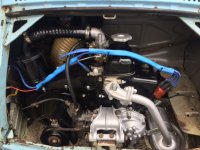AT LAST.
On the road properly.
Parts arrived from Passione, and it was straight to work. The manifold and some gaskets had to be fitted to the exhaust that Chris
Bambino sent my way. I can't express how grateful I am for this, the exhaust fits beautifully and she actually purrs!
Fitting the exhaust brackets is a total nightmare though. The new brackets, when aligned with the old ones, are ever so slightly smaller, enough to make fitting them a real pain in the... I had to bend them slightly as they're round and the exhaust is slightly oval shaped. Then I had to grab some large locking pliers to bring the ends together and put the bolts in. Sounds easy but the whole process took several hours.
Anyway, success! I'd tidied up the engine bay a bit while awaiting the parts and it looks a lot better now. Got some heatshrink wrap as sleeves to insulate the leads, as they were at risk of falling against some hot spots and melting. If I can find some proper grommets for the metal lead holders, then the wrap probably won't be necessary.
Took her out for a properish drive to get the brakes sorted. The shoes were rubbing on the drum ever since I'd been troubleshooting an odd rattle sound, which turned out to be the spring on the wrong side of a metal tab, as pointed out by eagle eyed fiat500. Lots of runs slamming on brakes, especially in reverse down a steep driveway and finally they have adjusted! An odd whirring sound remains but I'll deal with that later.
She's slowly getting to the point of being ready to run.
Latest issue is on hard acceleration, feeling like she stutters intermittently.
Speeds up then stutters, then speeds up, stutters.
From reading around, could this be the valve clearances?
I have some feeler gauges and plan to adjust as per Toshi's advice here:
https://www.fiatforum.com/500-classic/341467-valve-clearances.html?p=3396329
Only problem is I don't actually know which bit needs adjusting!
Other thoughts were if it might be the carb?
I played around adjusting the mixture and idle screws but feel like I'm just guessing really. I did see a good guide here somewhere about how to best adjust the mixture+idle screws in harmony.
Thank you everyone for all the help so far, I couldn't face this little project without your help!






